Global Satellite-Based ET Products for the Local Level Irrigation Management: An Application of Irrigation Performance Assessment in the Sugarbelt of Swaziland
Abstract
:1. Introduction
2. Materials and Methods
2.1. Study Area
2.2. Datasets
2.3. Methodology
2.3.1. Potential evapotranspiration
2.3.2. Irrigation Performance Assessment
3. Results
3.1. Evapotranspiration and Potential Evoptranspiration
3.2. Irrigation Performance Assessment
3.2.1. Equity
3.2.2. Adequacy
3.2.3. Reliability
3.2.4. Crop Water Productivity
3.2.5. Relation of All Indicators
4. Discussion
Relationship of All Indicators
5. Conclusions
Author Contributions
Acknowledgments
Conflicts of Interest
References
- Steffen, W.; Richardson, K.; Rockström, J.; Cornell, S.E.; Fetzer, I.; Bennett, E.M.; Biggs, R.; Carpenter, S.R.; De Vries, W.; De Wit, C.A.; et al. Planetary boundaries: Guiding human development on a changing planet. Science 2015, 347, 1259855. [Google Scholar] [CrossRef]
- Molden, D.J. Water for Food, Water for Life: A Comprehensive Assessment of Water Management in Agriculture; Routledge: Abington, UK, 2007; ISBN 9781844073962. [Google Scholar]
- Conijn, J.G.; Bindraban, P.S.; Schröder, J.J.; Jongschaap, R.E.E. Can our global food system meet food demand within planetary boundaries? Agric. Ecosyst. Environ. 2018, 251, 244–256. [Google Scholar] [CrossRef]
- Rockstrom, J.; Lannerstad, M.; Falkenmark, M. Assessing the water challenge of a new green revolution in developing countries. Proc. Natl. Acad. Sci. USA 2007, 104, 6253–6260. [Google Scholar] [CrossRef] [Green Version]
- Falkenmark, M.; Rockström, J.; Karlberg, L. Present and future water requirements for feeding humanity. Food Secur. 2009, 1, 59–69. [Google Scholar] [CrossRef]
- Alcamo, J.; Flörke, M.; Märker, M. Future long-term changes in global water resources driven by socio-economic and climatic changes. Hydrol. Sci. J. 2007, 52, 247–275. [Google Scholar] [CrossRef] [Green Version]
- Rockström, J.; Gordon, L. Assessment of green water flows to sustain major biomes of tthe world: Implications for future ecohydrological landscape management. Phys. Chem. Earth Part B Hydrol. Ocean. Atmos. 2001, 26, 843–851. [Google Scholar] [CrossRef]
- Hess, T.M.; Sumberg, J.; Biggs, T.; Georgescu, M.; Haro-Monteagudo, D.; Jewitt, G.; Ozdogan, M.; Marshall, M.; Thenkabail, P.; Daccache, A.; et al. A sweet deal? Sugarcane, water and agricultural transformation in Sub-Saharan Africa. Glob. Environ. Chang. 2016, 39, 181–194. [Google Scholar] [CrossRef] [Green Version]
- Swaziland Sugar Association (SSA). Annual Report.; Swaziland Sugar Association: Mbabane, Swaziland, 2013. [Google Scholar]
- Knox, J.W.; Rodríguez Díaz, J.A.; Nixon, D.J.; Mkhwanazi, M. A preliminary assessment of climate change impacts on sugarcane in Swaziland. Agric. Syst. 2010, 103, 63–72. [Google Scholar] [CrossRef] [Green Version]
- Swaziland Government. Integrated Water Resources Master Plan (IWRMP); Swaziland Government: Mbabane, Swaziland, 2011.
- Molden, D.J.; Sakthivadivel, R.; Habib, Z. Basin-Level Use and Productivity of Water: Examples from South Asia; International Water Management Institute: Colombo, Sri Lanka, 2001; Volume 49. [Google Scholar]
- Gowda, P.H.; Chavez, J.L.; Colaizzi, P.D.; Evett, S.R.; Howell, T.A.; Tolk, J.A. ET mapping for agricultural water management: Present status and challenges. Irrig. Sci. 2008, 26, 223–237. [Google Scholar] [CrossRef]
- Almazroui, M. Calibration of TRMM rainfall climatology over Saudi Arabia during 1998–2009. Atmos. Res. 2011, 9, 400–414. [Google Scholar] [CrossRef]
- Gowda, P.H.; Senay, G.B.; Howell, T.A.; Marek, T.H. Lysimetric evaluation of simplified surface energy balance approach in the Texas high plains. Appl. Eng. Agric. 2009, 25, 665–669. [Google Scholar] [CrossRef]
- Immerzeel, W.W.; Rutten, M.M.; Droogers, P. Spatial downscaling of TRMM precipitation using vegetative response on the Iberian Peninsula. Remote Sens. Environ. 2009, 113, 362–370. [Google Scholar] [CrossRef]
- Jia, S.; Zhu, W.; Lu, A.; Yan, T. A statistical spatial downscaling algorithm of TRMM precipitation based on NDVI and DEM in the Qaidam Basin of China. Remote Sens. Environ. 2011, 115, 3069–3079. [Google Scholar] [CrossRef] [Green Version]
- Kumar, D.N.; Reshmidevi, T.V. Remote sensing applications in water resources. J. Indian Inst. Sci. 2013, 93, 163–188. [Google Scholar]
- Bastiaanssen, W.G.M.; Bos, M.G. Irrigation performance indicators based on remotely sensed data: A review of literature. Irrig. Drain. Syst. 1999, 13, 291–311. [Google Scholar] [CrossRef]
- Zwart, S.J.; Leclert, L.M.C. A remote sensing-based irrigation performance assessment: A case study of the Office du Niger in Mali. Irrig. Sci. 2010, 28, 371–385. [Google Scholar] [CrossRef]
- Pareeth, S.; Karimi, P.; Shafiei, M.; De Fraiture, C. Mapping agricultural landusep from time series of Landsat 8 using random forest based hierarchial approach. Remote Sens. 2019, 11, 601. [Google Scholar] [CrossRef]
- Bastiaanssen, W.G.M.; Pelgrum, H.; Wang, J.; Ma, Y.; Moreno, J.F.; Roerink, G.J.; Van Der Wal, T. A remote sensing surface energy balance algorithm for land (SEBAL): 2. Validation. J. Hydrol. 1998, 212–213, 213–229. [Google Scholar] [CrossRef]
- Conrad, C.; Dech, S.W.; Hafeez, M.; Lamers, J.P.A.; Tischbein, B. Remote sensing and hydrological measurement based irrigation performance assessments in the upper Amu Darya Delta, Central Asia. Phys. Chem. Earth 2013, 61–62, 52–62. [Google Scholar] [CrossRef]
- Droogers, P.; Bastiaanssen, W.G.M. Irrigation Performance using Hydrological and Remote Sensing Modeling. J. Irrig. Drain. 2002, 128, 11–18. [Google Scholar] [CrossRef]
- Fang, J.; Du, J.; Xu, W.; Shi, P.; Li, M.; Ming, X. Spatial downscaling of TRMM precipitation data based on the orographical effect and meteorological conditions in a mountainous area. Adv. Water Resour. 2013, 61, 42–50. [Google Scholar] [CrossRef]
- Roerink, G.J.; Bastiaanssen, W.G.M.; Chambouleyron, J.; Menenti, M. Relating Crop Water Consumption to Irrigation Water Supply by Remote Sensing. Water Resour. Manag. 1997, 11, 445–465. [Google Scholar] [CrossRef]
- Kharrou, M.H.; Le Page, M.; Chehbouni, A.; Simonneaux, V.; Er-Raki, S.; Jarlan, L.; Ouzine, L.; Khabba, S.; Chehbouni, G. Assessment of Equity and Adequacy of Water Delivery in Irrigation Systems Using Remote Sensing-Based Indicators in Semi-Arid Region, Morocco. Water Resour. Manag. 2013, 27, 4697–4714. [Google Scholar] [CrossRef]
- Velpuri, N.M.; Senay, G.B.; Singh, R.K.; Bohms, S.; Verdin, J.P. A comprehensive evaluation of two MODIS evapotranspiration products over the conterminous United States: Using point and gridded FLUXNET and water balance ET. Remote Sens. Environ. 2013, 139, 35–49. [Google Scholar] [CrossRef]
- Taghvaeian, S.; Neale, C.M.U.; Osterberg, J.C.; Sritharan, S.I.; Watts, D.R. Remote Sensing and GIS Techniques for Assessing Irrigation Performance: Case Study in Southern California. J. Irrig. Drain. Eng. 2018, 144, 05018002. [Google Scholar] [CrossRef]
- Bos, M.G.; Burton, M.; Molden, D.J. Irrigation and Drainage Performance Assessment. Practical Guidelines; CABI Publishing: London, UK, 1999; ISBN 0851999670. [Google Scholar]
- Senay, G.B.; Budde, M.; Verdin, J.P.; Melesse, A.M. A coupled remote sensing and simplified surface energy balance approach to estimate actual evapotranspiration from irrigated fields. Sensors 2007, 7, 979–1000. [Google Scholar] [CrossRef]
- Esterhuizen, D.; Kreamer, R. Sugar Annual Report: Production and usage of sugar in Swaziland; USDA: Washington, DC, USA, 2012. [Google Scholar]
- Malano, H.M.; van Hofwegen, P. Management of Irrigation and Drainage Systems; CRC Press: Boca Raton, FL, USA, 1999; ISBN 90-5410-483-X. [Google Scholar]
- Senay, G.B.; Budde, M.E.; Verdin, J.P. Enhancing the Simplified Surface Energy Balance (SSEB) approach for estimating landscape ET: Validation with the METRIC model. Agric. Water Manag. 2011, 98, 606–618. [Google Scholar] [CrossRef]
- Guerschman, J.P.; Van Dijk, A.I.J.M.J.M.; Mattersdorf, G.; Beringer, J.; Hutley, L.B.; Leuning, R.; Pipunic, R.C.; Sherman, B.S. Scaling of potential evapotranspiration with MODIS data reproduces flux observations and catchment water balance observations across Australia. J. Hydrol. 2009, 369, 107–119. [Google Scholar] [CrossRef]
- Senay, G.B.; Schauer, M.; Friedrichs, M.; Velpuri, N.M.; Singh, R.K. Satellite-based water use dynamics using historical Landsat data (1984–2014) in the southwestern United States. Remote Sens. Environ. 2017, 202, 98–112. [Google Scholar] [CrossRef]
- King, E.A.; Van Niel, T.G.; Van Dijk, A.I.J.M.; Wang, Z.; Paget, M.J.; Raupach, T.; Guerschman, J.; Haverd, V.; Mcvicar, T.R.; Miltenburg, I.; et al. Actual Evapotranspiration Estimates for Australia Inter-Comparison and Evaluation; CSIRO: Canberra, Australia, 2011. [Google Scholar]
- Hofste, R.W. Comparative Analysis among Near-Operational Evapotranspiration Products for the Nile Basin Based on Earth Observations. Master’s Thesis, TU Delft, Delft, The Netherlands, 2014. [Google Scholar]
- Da Motta Paca, V.H.; Espinoza-Dávalos, G.E.; Hessels, T.M.; Moreira, D.M.; Comair, G.F.; Bastiaanssen, W.G.M. The spatial variability of actual evapotranspiration across the Amazon River Basin based on remote sensing products validated with flux towers. Ecol. Process. 2019, 8, 6. [Google Scholar] [CrossRef]
- Prior, A. WA+ as a Technical Tool for Transboundary Water Governance: The Potential of Satellite Data for Water Accounting in Ungauged Basins. Master’s Thesis, Vrije Universiteit Brussel, Brussels, Belgium, 2016. [Google Scholar]
- Karimi, P.; Bastiaanssen, W.G.M. Spatial evapotranspiration, rainfall and land use data in water accounting—Part 1: Review of the accuracy of the remote sensing data. Hydrol. Earth Syst. Sci. 2015, 19, 507–532. [Google Scholar] [CrossRef]
- Hessels, T.M. Comparison and Validation of Several Open Access Remotely Sensed Rainfall Products for the Nile Basin. Master’s Thesis, TU Delft, Delft, The Netherlands, 2015. [Google Scholar]
- Toté, C.; Patricio, D.; Boogaard, H.; van der Wijngaart, R.; Tarnavsky, E.; Funk, C. Evaluation of satellite rainfall estimates for drought and flood monitoring in Mozambique. Remote Sens. 2015, 7, 1758–1776. [Google Scholar] [CrossRef]
- Bezuidenhout, C.N.; Lecler, N.L.; Gers, C.; Lyne, P.W.L. Regional based estimates of water use for commercial sugar-cane in South Africa. Water SA 2006. [Google Scholar] [CrossRef]
- Alexandridris, T.; Asif, S.; Ali, S. Water Performance Indicators Using Satellite Imegery for the Fordwah Eastern Sadiqia (South) Irrigation and Drainage Project; International Water Management Institute: Colombo, Sri Lanka, 1999; pp. 1–30. [Google Scholar]
- Bastiaanssen, W.; Bandara, K. Evaporative depletion assessments for irrigated watersheds in Sri Lanka. Irrig. Sci. 2001, 21, 1–15. [Google Scholar]
- Ahmad, M.D.; Turral, H.; Nazeer, A. Diagnosing irrigation performance and water productivity through satellite remote sensing and secondary data in a large irrigation system of Pakistan. Agric. Water Manag. 2009, 96, 551–564. [Google Scholar] [CrossRef]
- Bastiaanssen, W.G.M.; Brito, R.A.L.; Bos, M.G.; Souza, R.A.; Cavalcanti, E.B.; Bakker, M.M. Low cost satellite data for monthly irrigation performance monitoring: Benchmarks from Nilo Coelho, Brazil. Irrig. Drain. Syst. 2001, 15, 53–79. [Google Scholar] [CrossRef]
- Kirkham, M.B. Potential Evapotranspiration. In Principles of Soil and Plant Water Relations; Elsevier Inc.: Amsterdam, The Netherlands, 2005; pp. 455–468. [Google Scholar]
- Stewart, J.; Hagan, R.; Pruitt, W.; Danielson, R.; Franklin, W.; Hanks, R.; Riley, J.; Jackson, E. Optimizing Crop Production through Control of Water and Salinity Levels in the Soil; The University of Utah: Salt Lake City, UT, USA, 1977. [Google Scholar]
- Allen, R.G.; Pereira, L.S.; Raes, D.; Smith, M. Crop Evapotranspiration: Guidelines for Computing Crop Requirements; FAO Irrigation and Drainage Paper No. 56; FAO: Rome, Italy, 1998. [Google Scholar]
- Bandara, K.M.P. Assessing Irrigation Performance by Using Remote Sensing. Ph.D. Thesis, Wageningen University, Wageningen, The Netherlands, 2006. [Google Scholar]
- Ellis, R.D.; Lankford, B.A. The tolerance of sugarcane to water stress during its main development phases. Agric. Water Manag. 1990, 17, 117–128. [Google Scholar] [CrossRef]
- Hellegers, P.J.G.J.; Soppe, R.; Perry, C.J.; Bastiaanssen, W.G.M. Remote Sensing and Economic Indicators for Supporting Water Resources Management Decisions. Water Resour. Manag. 2010, 24, 2419–2436. [Google Scholar] [CrossRef]
- Perry, C. Irrigation reliability and the productivity of water: A proposed methodology using evapotranspiration mapping. Irrig. Drain. Syst. 2005, 19, 211–221. [Google Scholar] [CrossRef]
- Karimi, P.; Molden, D.; Notenbaert, A.; Peden, D. Nile basin farming systems and productivity. In The Nile River Basin: Water, Agriculture, Governance and Livelihoods; Awulachew, S.B., Smakhtin, V., Molden, D., Peden, D., Eds.; Routledge-Earthscan: Abingdon, UK, 2012; pp. 133–153. [Google Scholar]
- Cai, X.; Sharma, B.R.; Matin, M.A.; Sharma, D.; Gunasinghe, S. An Assessment of Crop Water Productivity in the Indus and Ganges River Basins: Current Status and Scope for Improvement; International Water Management Institute: Colombo, Sri Lanka, 2010; Volume 140, ISBN 9789290907350. [Google Scholar]
- Kruger, F.; Bosch, J.; Everson, C.; Burger, C. Land-Based Activities that May Be Declared Stream Flow Reduction Activities in Terms of Section 36 of the National Water Act; Report to the Sub-Directorate: Stream Flow Reduction Activities of the Department of Water Affairs and Forestry, South Africa; Department of Water Affairs and Forestry: Pretoria, South Africa, 2000. [Google Scholar]
- Steduto, P.; Hsiao, T.C.; Fereres, E.; Raes, D. Crop Yield Response to Water; FAO: Rome, Italy, 2012; ISBN 9789251072745. [Google Scholar]
- Carr, M.K.V.; Knox, J.W. The Water Relations and Irrigation Requirements of Sugar Cane (Saccharum officinarum): A Review. Exp. Agric. 2011, 47, 1–25. [Google Scholar] [CrossRef]
- Zwart, S.J.; Bastiaanssen, W.G.M. Review of measured crop water productivity values for irrigated wheat, rice, cotton and maize. Agric. Water Manag. 2004, 69, 115–133. [Google Scholar] [CrossRef]
- Bastiaanssen, W.G.M.; Steduto, P. The water productivity score (WPS) at global and regional level: Methodology and first results from remote sensing measurements of wheat, rice and maize. Sci. Total Environ. 2017, 575, 595–611. [Google Scholar] [CrossRef]
- Blatchford, M.L.; Karimi, P.; Bastiaanssen, W.G.M.; Nouri, H. From Global Goals to Local Gains—A Framework for Crop Water Productivity. ISPRS Int. J. Geo-Inf 2018, 7, 414. [Google Scholar] [CrossRef]
- Molden, D.J.; Gates, T.K. Performance Measures for Evaluation of Irrigation-Water-Delivery Systems. J. Irrig. Drain Eng. 1990, 116, 804–823. [Google Scholar] [CrossRef]
- Malaza, S.; Myeni, D. Integrating Smallholder Growers into Competitive Sugarcane Production; South African Sugar Technologists’ Association: Pretoria, South Africa, 2009. [Google Scholar]
- Swaziland Cane Growers Association. Terms of Reference: Assessment of Irrigation Systems for Smallholder Sugarcane Growers; Swaziland Cane Growers Association: Mbabane, Swaziland, 2012. [Google Scholar]
- Annandale, J.G.; Stirzaker, R.J.; Singels, A.; van der Laan, M.; Laker, M.C. Irrigation scheduling research: South African experiences and future prospects. Water SA 2011, 37, 751–764. [Google Scholar] [CrossRef]
- Merry, R.E. “Dripping with success”: The challenges of an irrigation redevelopment project. Irrig. Drain. 2003, 52, 71–83. [Google Scholar] [CrossRef]
- Hellegers, P.J.G.J.; Soppe, R.; Perry, C.J.; Bastiaanssen, W.G.M. Combining remote sensing and economic analysis to support decisions that affect water productivity. Irrig. Sci. 2009, 27, 243–251. [Google Scholar] [CrossRef]
- Magwenzi, O. Efficiency of subsurface drip irrigation in commercial sugarcane field in Swaziland. In Proceedings of the Annual General Meeting of the South African Sugarcane Agronomists Association, Mount Edgecomb, Swaziland, 30 July–02 August 2001. [Google Scholar]
- Reinders, F.B.; van der Stoep, I.; Backeberg, G.R. Improved efficiency of irrigation water use: A south african framework. Irrig. Drain. 2013, 62, 262–272. [Google Scholar] [CrossRef]
- Lankford, B. The Rise of Large Scale Formal Smallholder Irrigation Schemes in Swaziland; An Appropriate Solution for Rural Livelihoods and Agricultural Production? DEV Working Paper Series; University of East Anglia: Norwich, UK, 2007. [Google Scholar]
- Karimi, P.; Molden, D.; Bastiaanssen, W.; Cai, X. Water accounting to assess use and productivity of water: Evolution of a concept and new frontiers. In Water Accounting: International Approaches to Policy and Decision-Making; Chalmers, K., Godfrey, J., Eds.; Edgar Elger: Cheltenham, UK, 2012; pp. 76–88. [Google Scholar]
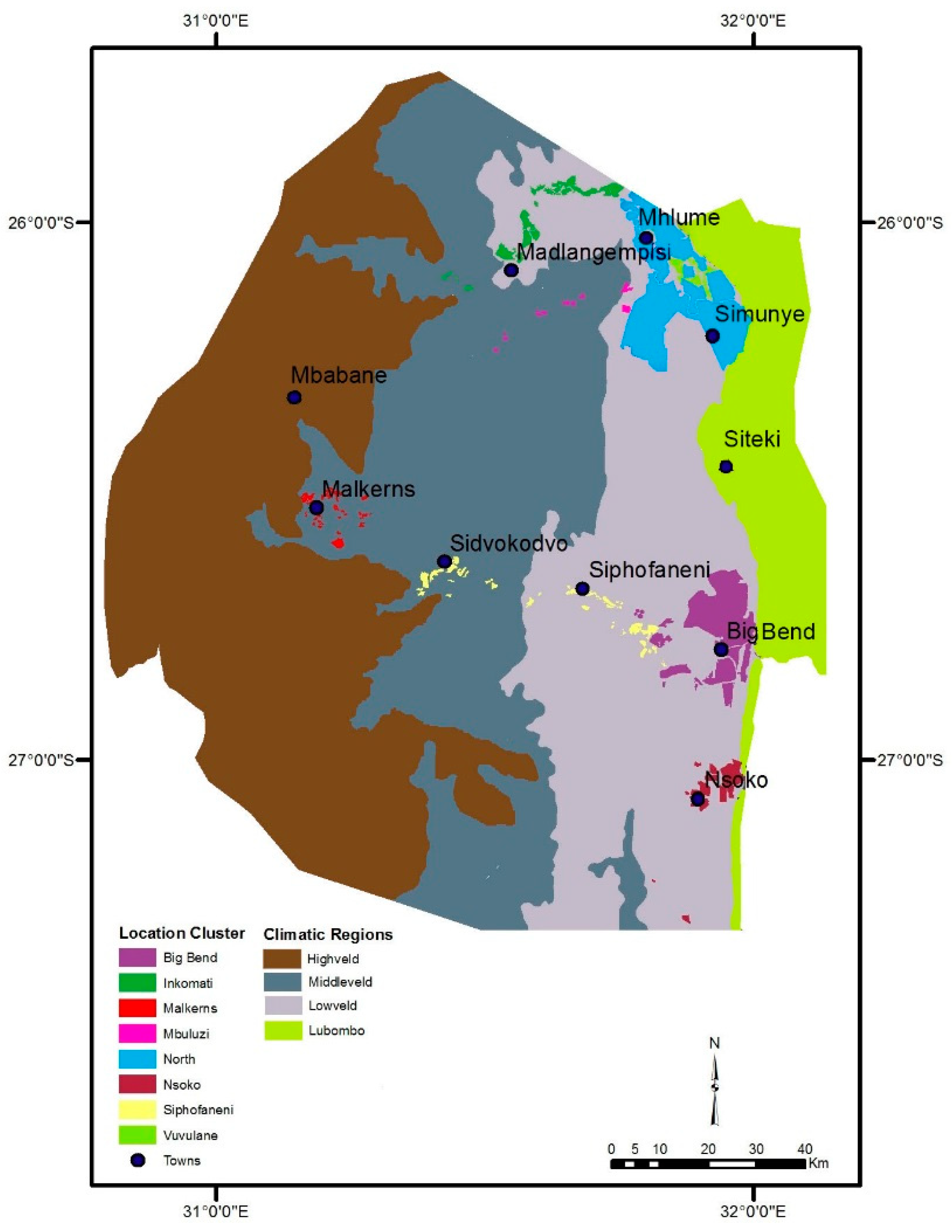

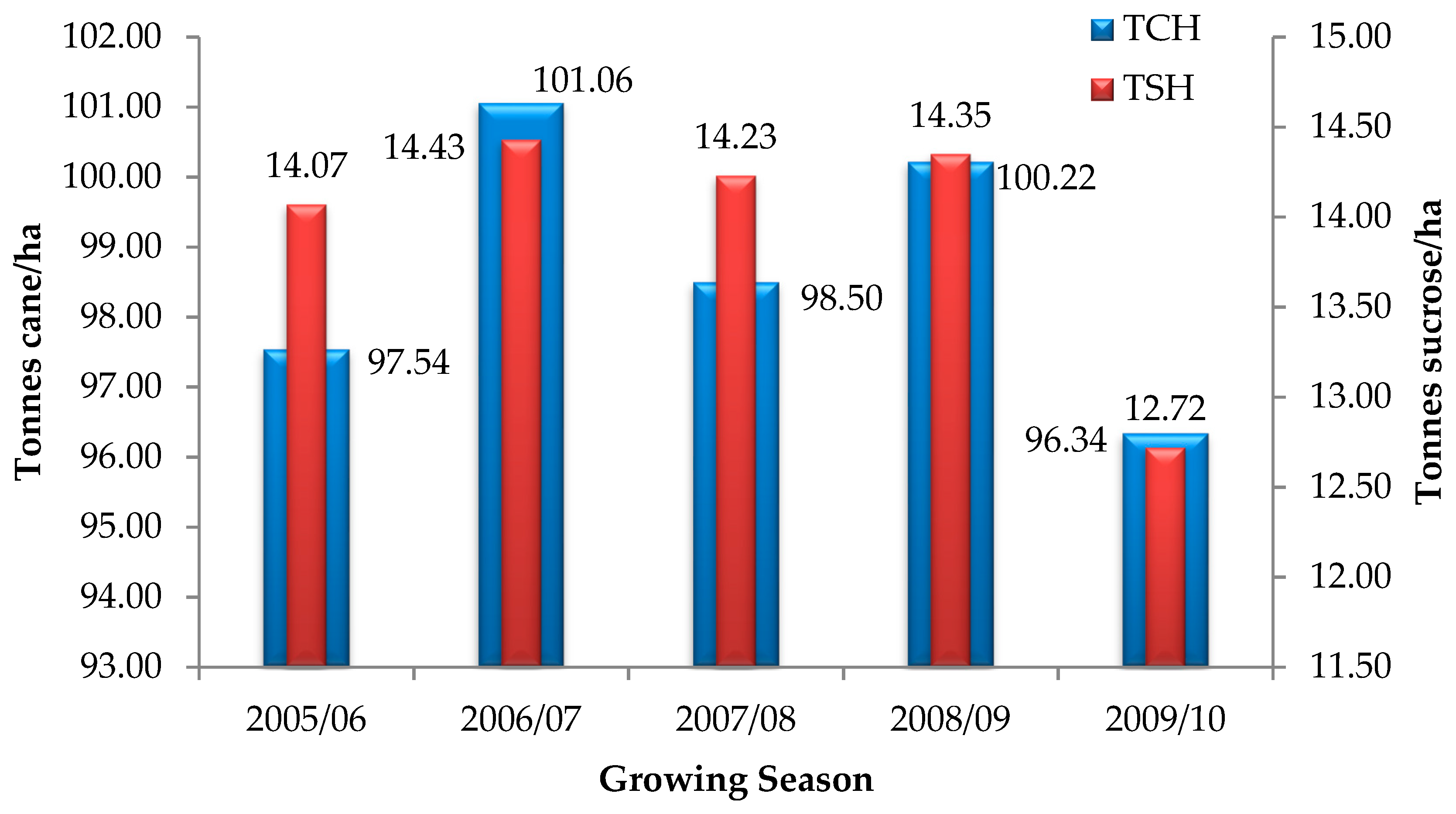
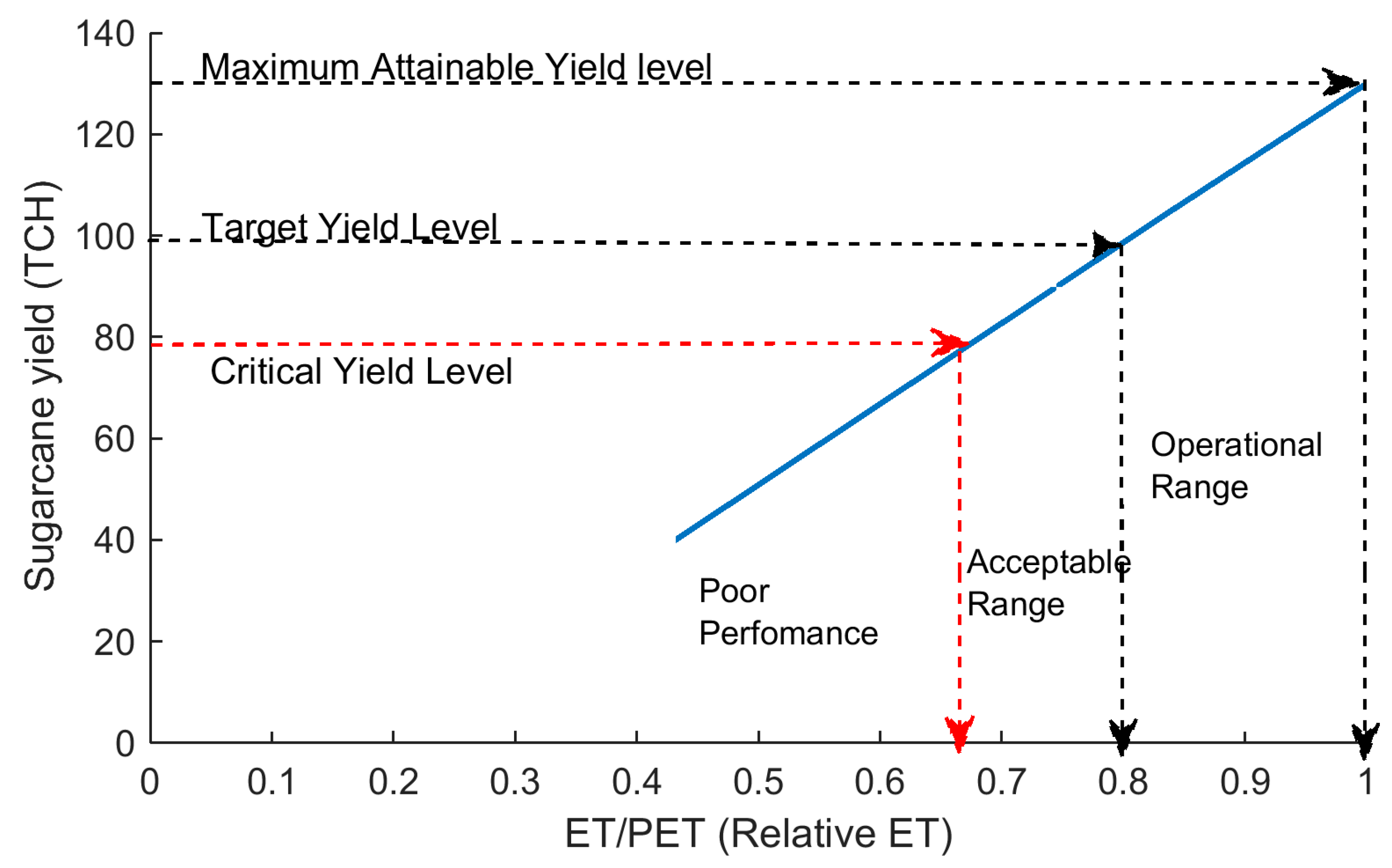
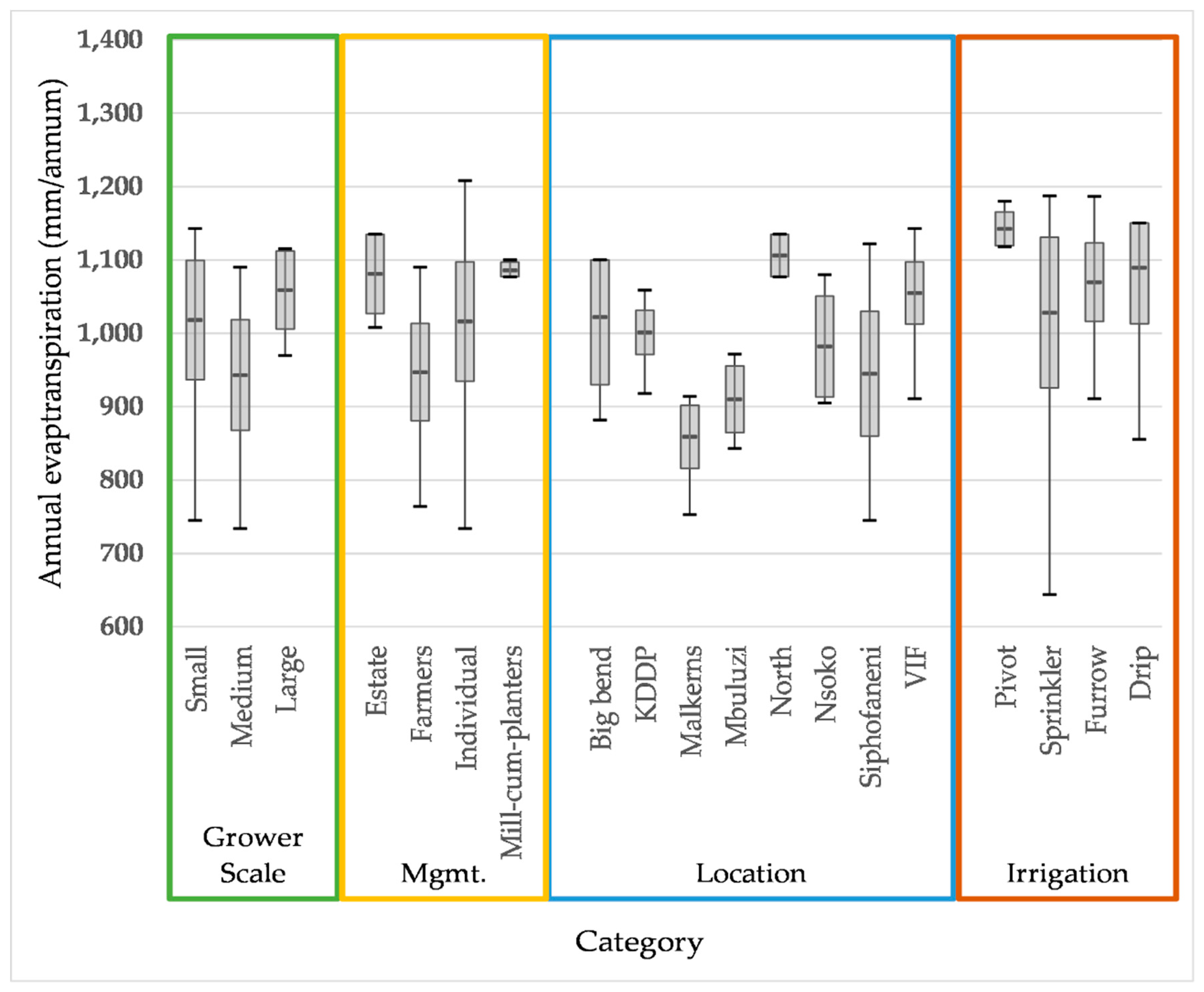
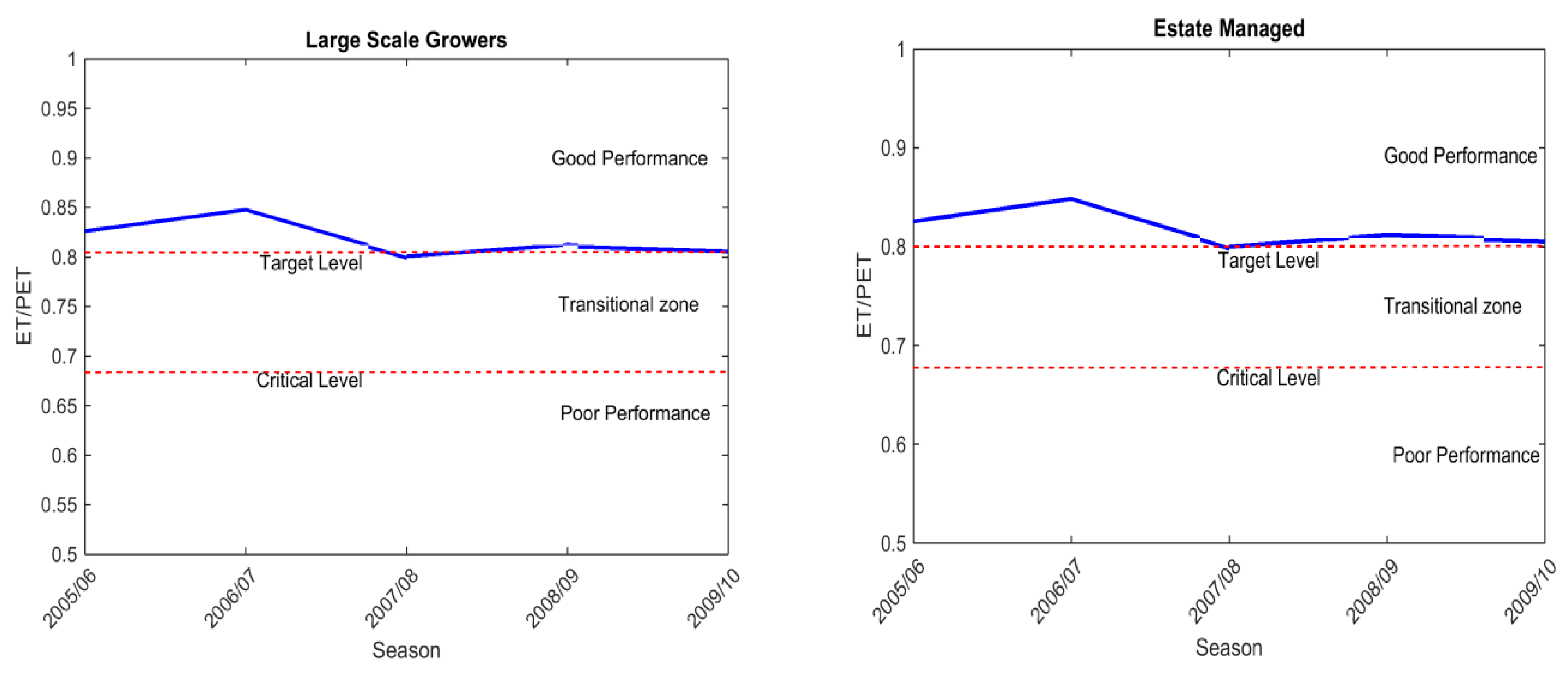
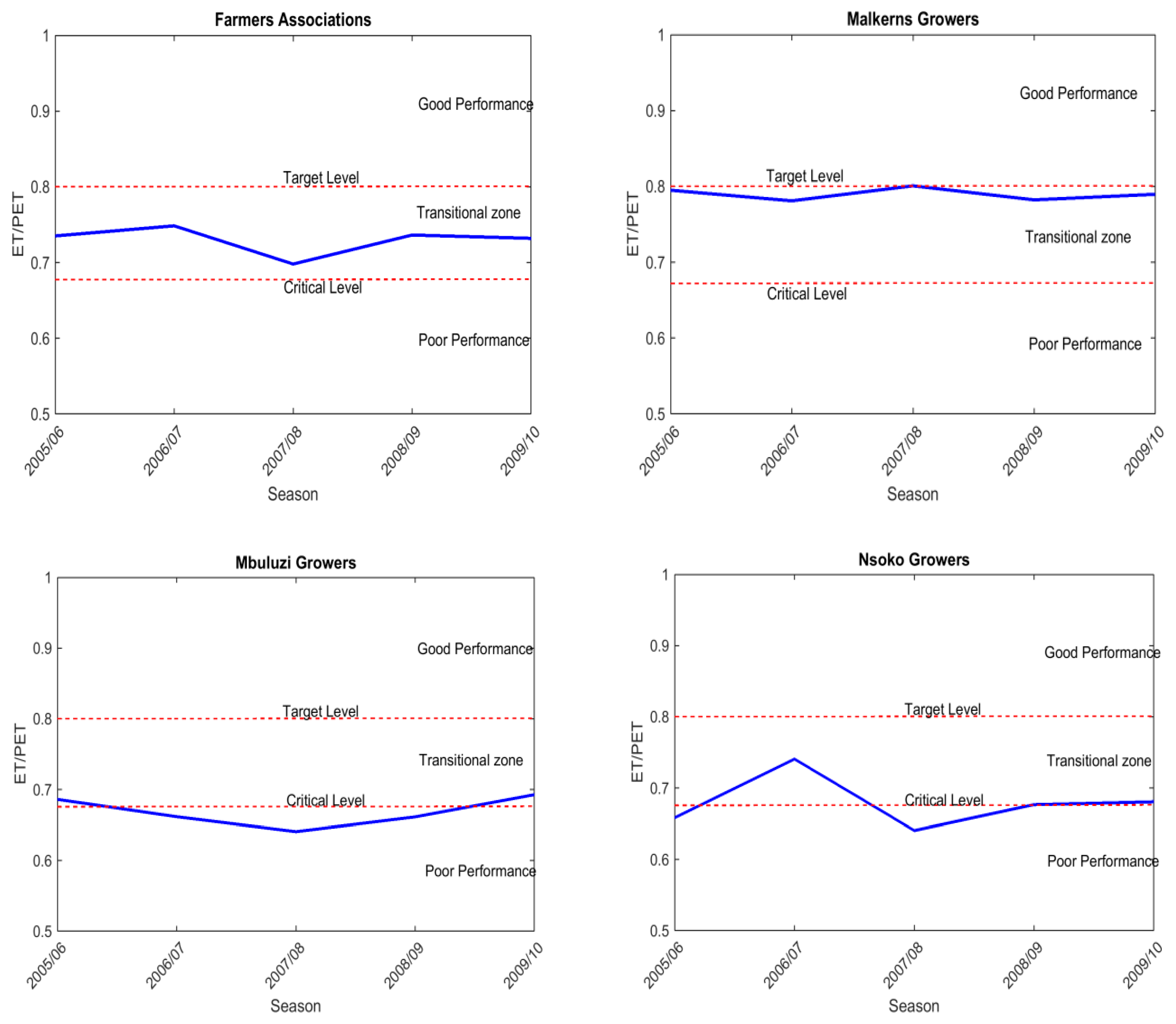

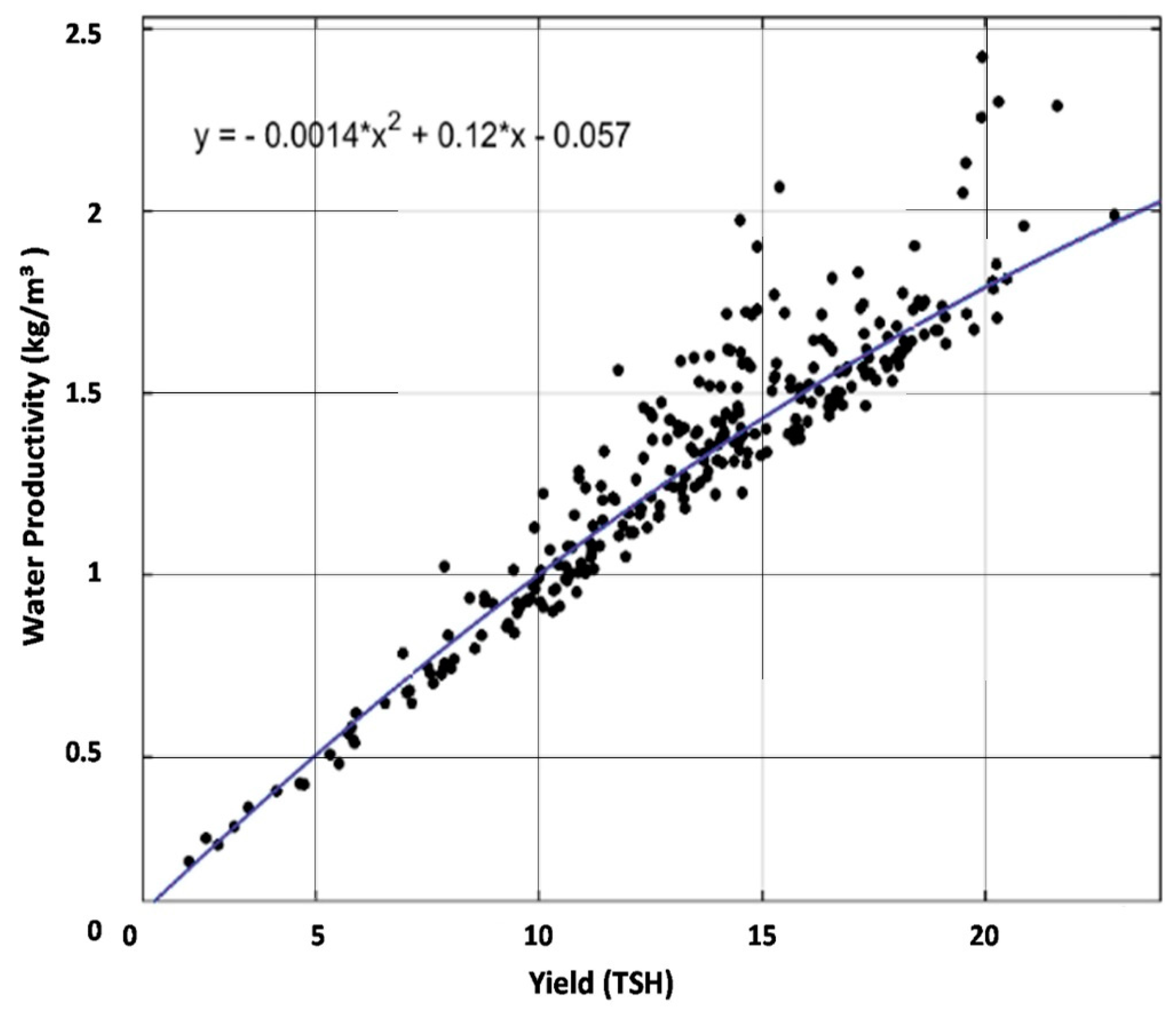

| Category | Cluster Name | Command Area | Type of Management |
|---|---|---|---|
| Land Holding | Small Scale Growers | <50 ha | Run along modern business lines |
| Medium Scale Grower | 50 ≥ 1000 ha | Farmer managed and commercial growers | |
| Large Scale Grower | >1000 ha | Farmers Associations and commercial growers | |
| Management Type | Estate managed | >1000 ha | Run along modern business lines |
| Miller-cum-planters | >1000 ha | Run along modern business lines | |
| Farmers Associations | 50–500 ha per farm | Farmer managed—communally | |
| Individual growers | 3–100 ha per farm | Farmer managed—individually | |
| Location | Incomati (KDDP) | 4,500 ha | Farmer managed—communally |
| North | 26,000 ha | Run along modern business lines | |
| Vuvulane (VIF) | 1470 ha | Farmer managed—individually | |
| Malkerns | 1100 ha | Farmers Associations and commercial growers | |
| Siphofaneni (including Sidvokodvo and LUSIP farmers) | 3500 ha | Farmers Associations and commercial growers | |
| Big Bend | 16,500 ha | Farmers Associations and commercial growers | |
| Nsoko | 3000 ha | Farmers Associations and commercial growers | |
| Mbuluzi | 900 ha | Farmers Associations and individual growers | |
| Irrigation method | Center Pivot | 12% | - |
| Sprinkler | 45% | - | |
| Furrow | 22% | - | |
| Drip | 20% | - |
| Criteria | Performance Indicator | Definition |
|---|---|---|
| Equity | CV of evapotranspiration | |
| Adequacy | Relative Evapotranspiration | |
| Reliability | Temporal variation of the relative evapotranspiration | |
| Productivity | Crop Water Productivity (CWP) |
| Grower Cluster | The 95 Percentile ET (mm/yr) | Industry Norm PET (mm/yr) |
|---|---|---|
| Komati | 1160 | 1200 |
| Vuvulane | ||
| North | 1231 | 1365 |
| Mbuluzi | ||
| Malkerns | 1004 | 1088 |
| Siphofaneni | ||
| Big Bend | 1191 | 1348 |
| Nsoko | ||
| Average | 1147 | 1250 |
| Category Name | Cluster Name | ET | Equity | Adequacy | Yield | Water Productivity | |
|---|---|---|---|---|---|---|---|
| (mm/yr) | CV of ET | RET | CV of RET | TSH (tones) | kg/m3 | ||
| Grower scale | Small Scale | 1018 | 0.08 | 0.75 | 0.08 | 11.58 | 1.15 |
| Medium Scale | 943 | 0.08 | 0.74 | 0.10 | 13.52 | 1.44 | |
| Large Scale | 1060 | 0.05 | 0.81 | 0.03 | 15.09 | 1.37 | |
| Management regime of grower | Estate Managed | 1080 | 0.05 | 0.80 | 0.04 | 17.42 | 1.57 |
| Farmers Associations | 947 | 0.07 | 0.73 | 0.11 | 13.43 | 1.42 | |
| Individual Growers | 1016 | 0.08 | 0.76 | 0.07 | 11.50 | 1.14 | |
| Mill-cum-planters | 1086 | 0.01 | 0.80 | 0.02 | 15.22 | 1.44 | |
| Location of growers | Big Bend | 1022 | 0.09 | 0.74 | 0.08 | 13.46 | 1.35 |
| KDDP | 1000 | 0.03 | 0.82 | 0.05 | 14.56 | 1.48 | |
| Malkerns | 859 | 0.05 | 0.79 | 0.05 | 13.95 | 1.63 | |
| Mbuluzi | 910 | 0.05 | 0.67 | 0.05 | 13.58 | 1.49 | |
| North | 1106 | 0.03 | 0.81 | 0.03 | 16.04 | 1.57 | |
| Nsoko | 982 | 0.07 | 0.71 | 0.08 | 13.88 | 1.41 | |
| Siphofaneni | 945 | 0.09 | 0.70 | 0.09 | 13.01 | 1.38 | |
| VIF | 1055 | 0.04 | 0.77 | 0.04 | 10.75 | 1.02 | |
| Irrigation method | Pivot | 1142 | 0.02 | 0.84 | 0.02 | 18.61 | 1.63 |
| Sprinkler | 1028 | 0.10 | 0.78 | 0.09 | 15.52 | 1.52 | |
| Furrow | 1070 | 0.05 | 0.83 | 0.07 | 12.20 | 1.13 | |
| Drip | 1090 | 0.07 | 0.81 | 0.05 | 16.18 | 1.48 | |
© 2019 by the authors. Licensee MDPI, Basel, Switzerland. This article is an open access article distributed under the terms and conditions of the Creative Commons Attribution (CC BY) license (http://creativecommons.org/licenses/by/4.0/).
Share and Cite
Karimi, P.; Bongani, B.; Blatchford, M.; de Fraiture, C. Global Satellite-Based ET Products for the Local Level Irrigation Management: An Application of Irrigation Performance Assessment in the Sugarbelt of Swaziland. Remote Sens. 2019, 11, 705. https://doi.org/10.3390/rs11060705
Karimi P, Bongani B, Blatchford M, de Fraiture C. Global Satellite-Based ET Products for the Local Level Irrigation Management: An Application of Irrigation Performance Assessment in the Sugarbelt of Swaziland. Remote Sensing. 2019; 11(6):705. https://doi.org/10.3390/rs11060705
Chicago/Turabian StyleKarimi, Poolad, Bhembe Bongani, Megan Blatchford, and Charlotte de Fraiture. 2019. "Global Satellite-Based ET Products for the Local Level Irrigation Management: An Application of Irrigation Performance Assessment in the Sugarbelt of Swaziland" Remote Sensing 11, no. 6: 705. https://doi.org/10.3390/rs11060705
APA StyleKarimi, P., Bongani, B., Blatchford, M., & de Fraiture, C. (2019). Global Satellite-Based ET Products for the Local Level Irrigation Management: An Application of Irrigation Performance Assessment in the Sugarbelt of Swaziland. Remote Sensing, 11(6), 705. https://doi.org/10.3390/rs11060705






